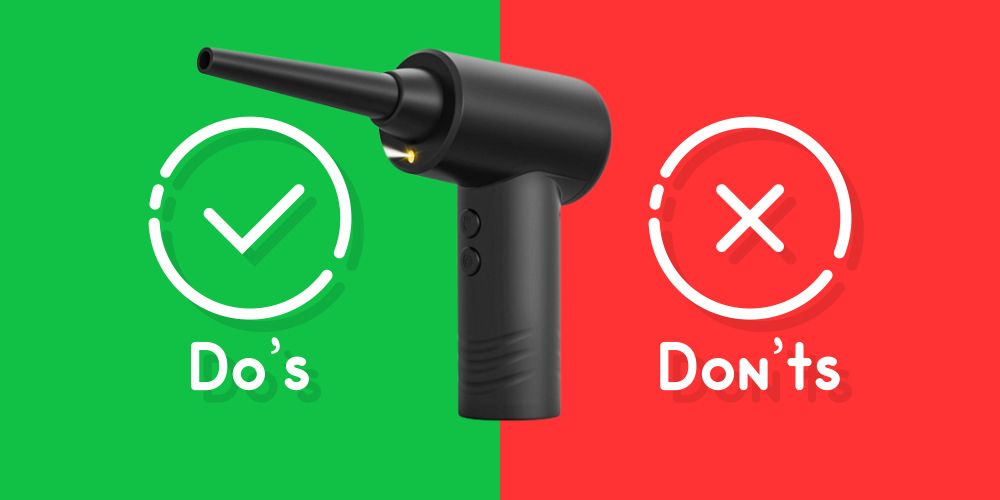Electric air dusters have become a popular and effective alternative to canned compressed air for cleaning dust from electronics and other hard-to-reach areas. When using an electric air duster, it is essential to follow certain do’s and don’ts to ensure optimal performance and safety. Knowing the proper techniques can help you maintain your valuable devices and extend their lifespan.
To achieve the best results, it is crucial to understand how to use the electric air duster correctly and follow proper maintenance practices.
Key Takeaways
- Electric air dusters are reusable, cost-effective, and safer than compressed air cans.
- Proper techniques when using electric air dusters ensure optimal performance and device maintenance.
- Understanding the do’s and don’ts when using an electric air duster is essential for prolonging the lifespan of your dusting devices.
Do’s
Carefully review the manufacturer’s instructions before utilizing the electric air duster.
One important step when using an electric air duster is always to read the manufacturer’s instructions. These instructions often include specific details on how to operate and maintain the device (Kinzir) safely. Familiarize yourself with the information provided to ensure you understand how to use the electric air duster properly.
Employ a face mask and protective goggles to guard against dust and particles.
While operating an electric duster, you must safeguard your eyes and lungs from airborne particles and dust by wearing safety goggles and a face mask. Such safety gear can greatly minimize the potential for harm or discomfort when utilizing an electric air duster.
Maintain at least 6 inches between the nozzle and the surface being cleaned with the electric air duster.
Maintain a safe distance between the electric air duster nozzle and the cleaned surface. It is recommended to keep the nozzle at least 6 inches away to avoid damage or dislodging components from delicate electronics and appliances.
Hold the electric air duster upright and avoid tilting it more than 45 degrees.
Ensure proper handling of the electric air duster by holding it upright and avoiding tilting it more than 45 degrees. This prevents potential damage to the equipment you are cleaning and ensures efficient airflow from the duster.
Use the electric air duster to clean in a well-ventilated area
Always clean with an electric air duster in a well-ventilated area, as this helps disperse dust and debris, reducing the risk of inhalation or build-up in the immediate surroundings.
Clean filters regularly
Frequent air filter cleaning will extend the life of your electric air duster and preserve its optimal performance. Clogged filters can reduce airflow and hinder cleaning efficiency, while well-maintained filters help to ensure effective dust removal from surfaces.
Make sure the air duster is unplugged before changing nozzles or cleaning
Before changing the nozzle or performing any maintenance on your electric air duster, ensure it is unplugged for safety precautions. By doing so, the potential for electrical shock or harm to the interior components of the device is reduced.
Store the electric air duster in a cool, dry place
Ensuring appropriate storage is critical for prolonging the functionality of an electric air duster. Maintain the device in a calm, dry location to shield it from moisture, heat, and humidity-induced harm. Additionally, it is important to store the device away from other flammable or combustible materials to reduce potential safety risks further.
Don’ts
Do not use the electric air duster to clean electronic devices while they are turned on.
Using an electric air duster on a device that is turned on can lead to issues like overheating, short-circuiting, and damaging the internal components. To maintain the efficiency of your electronic devices, always remember to turn them off and unplug them before using the electric air duster on them.
Do not overfill the electric air duster canister.
Overfilling the canister can lead to problems like freeze, smoke, or even a damaged motor. Always follow the manufacturer’s instructions for filling the air duster canister to prevent mishaps. Properly filling the canister ensures optimal performance and helps avoid any threats to the device’s functionality.
Don’t aim at the skin or eyes – it can cause injury.
When using an electric air duster, it’s important to avoid aiming the air stream at your skin or eyes. The air pressure can be powerful enough to cause injury or even damage your eyesight. Always be cautious and ensure you’re pointing the air duster away from yourself and others.
Don’t use near flames or heat – it can spread fire.
Electric air dusters should never be used around flames or heat sources, as they risk spreading fire. This could lead to serious burn injuries or even a larger fire hazard. Additionally, flammable materials should never be cleaned with an air duster, as the force of the air can spread flammable substances and create unsafe conditions.
Don’t use near hazardous dust – it can spread particles.
It’s essential to avoid using electric air dusters around hazardous dust or particles, as they can inadvertently disperse the harmful substances. For example, using an air duster around asbestos can expose you and others to toxic particles. If you encounter hazardous materials during cleaning, consider using a vacuum or other appropriate methods for safe removal.
Don’t tip vertically – it can damage the motor.
Overtipping an electric air duster by using it vertically can damage the motor. To prevent this issue, always use the air duster at a slight angle and avoid pointing it straight up or down. This practice will maintain the motor in the optimal operational state, thereby prolonging the durability of your electric air duster.
Don’t use it on wet surfaces.
Lastly, it’s important not to use an electric air duster on wet surfaces. The force of the air can blow around the water, potentially causing damage to electronic devices. Instead, allow wet surfaces to dry naturally or use a cloth or sponge to remove moisture. In certain cases, soapy water combined with hoses may be more effective in cleaning specific surfaces.
Conclusion
Electric air dusters are invaluable for cleaning electronics safely and effectively. Key usage tips include switching off and unplugging devices before use, using short bursts for efficient dust removal, holding the duster upright for consistent airflow, and cleaning a ventilated area to avoid dust accumulation. Avoid shaking the duster, using it near flammable substances, and inserting the nozzle into tight spaces to prevent damage or hazards. By following these guidelines, users can optimize their cleaning methods and extend the lifespan of their air dusters and equipment.
 Electric Air Duster Manufacturer in China – Kinzir
Electric Air Duster Manufacturer in China – Kinzir
